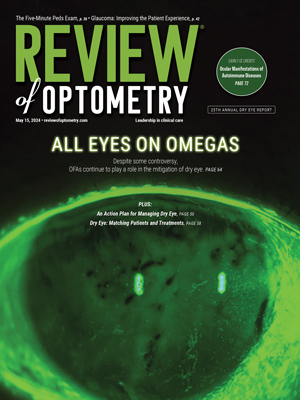 In November 2011, the anti-VEGF agent Eylea (aflibercept, Regeneron) initially received FDA approval for the treatment of neovascular age-related macular degeneration (AMD). In September 2012, the drug secured approval for a second indication: the treatment of macular edema associated with central retinal vein occlusion (CRVO).
In November 2011, the anti-VEGF agent Eylea (aflibercept, Regeneron) initially received FDA approval for the treatment of neovascular age-related macular degeneration (AMD). In September 2012, the drug secured approval for a second indication: the treatment of macular edema associated with central retinal vein occlusion (CRVO).
Like Lucentis (ranibizumab, Genentech/Roche)––the only other drug approved to treat both wet AMD and macular edema secondary to retinal vein occlusion––Eylea is administered via intravitreal injection. However, when used to treat wet AMD, Eylea may be dosed every eight weeks vs. every four weeks for Lucentis. Clearly, this injection frequency is appealing to both patients and treating physicians.
Eylea’s reduced dosing frequency likely is associated with the active ingredient’s longer half-life. (It should be noted, however, that the recommended dosing frequency for the treatment of macular edema associated with retinal vein occlusion is every four weeks for both Eylea and Lucentis.)
Eylea also exhibits a higher binding affinity to VEGF-A than Lucentis.1,2 This suggests that Eylea potentially could yield a more potent therapeutic effect than that rendered by other intravitreal anti-VEGF therapies.
Eylea for Macular Edema in Patients with CRVO
The use of anti-VEGF therapy for the treatment of macular edema secondary to CRVO demonstrated both structural and functional vision improvement in two key clinical trials––COPERNICUS and GALILEO.3,4 Both studies evaluated the safety and efficacy of Eylea for macular edema in CRVO patients, and ultimately helped to secure FDA approval for the drug’s second indication.
The study authors evaluated the long-term effects of Eylea over both six- and 12-month treatment intervals. In both studies, the primary endpoint was to achieve a visual gain of 15 or more ETDRS letters (equivalent to a three-line gain on the Snellen chart).5

Pronounced cystoid macular edema documented in a patient with CRVO. Could he benefit from Eylea therapy?
A total of 358 patients were enrolled in COPERNICUS and GALILEO. Of these, 217 were dosed with Eylea and the remaining 141 subjects received sham injections. In both studies, 2mg Eylea injections were administered monthly for the first six months and then as needed for the subsequent six months.
The same was true for the sham treatment group in COPERNICUS; however, subjects in the sham arm of GALILEO received monthly injections for an entire year.
At the six-month follow-up in COPERNICUS, 56.1% of patients who received Eylea gained at least 15 ETDRS letters from baseline acuity compared to just 12.3% of patients who had sham injections.3,5 Patients who were treated with Eylea gained an average of 17.3 ETDRS letters, which correlated with decreased macular thickness.3,5 Additionally, just 3.5% of patients who received Eylea experienced adverse events (e.g., conjunctival hemorrhage, reduced visual acuity and ocular pain) vs. 13.5% of patients who received sham injections.3
Patients in GALILEO experienced similar results. After six months, 60.2% of patients who were treated with Eylea gained 15 ETDRS letters versus 22% of patients who received sham injections.5 Further, patients in the treatment group achieved an average visual acuity gain of 18 ETDRS letters.5
At the one-year follow-up, patients in both studies who received Eylea exhibited comparable visual improvement levels to those documented at six months. However, approximately 30% of patients in both studies who received sham injections achieved a 15-letter gain after one year of placebo therapy.6
Fewer Doses for Patients with CRVO?
One of the greatest hopes for Eylea is that, eventually, it safely could be dosed every other month for the treatment of macular edema associated with CRVO. Much like those who receive Eylea for wet AMD, this reduced dosing frequency could lower the physical, psychological and financial burdens on CRVO patients with macular edema. However, further studies will be required to determine the safest and most effective dosing schedule.
For now, Eylea remains the latest “wonder drug” in the realm of retinal vascular disease. Currently, Phase 3 clinical trials are evaluating the effect of Eylea for other retinal complications, including diabetic macular edema.7 Only time will tell if the drug truly can live up to its promise and clinical expectations.
Thanks to Jeffry D. Gerson, O.D., of Shawnee, Kans., for contributing this article.
1. Gaudreault J, Fei D, Rusit J, et al. Preclinical pharmacokinetics of Ranibizumab (rhuFabV2) after a single intravitreal administration. Invest Ophthalmol Vis Sci. 2005 Feb;46(2):726-33.
2. Stewart MW. Clinical and differential utility of VEGF inhibitors in wet age-related macular degeneration: focus on aflibercept. Clin Ophthalmol. 2012;6:1175-86.
3. Boyer D, Heier J, Brown DM, et al. Vascular endothelial growth factor Trap-Eye for macular edema secondary to central retinal vein occlusion: six-month results of the phase 3 COPERNICUS study. Ophthalmology. 2012 May;119(5):1024-32.
4. Bayer. A randomized, double-masked, sham-controlled Phase 3 study of the efficacy, safety and tolerability of repeated intravitreal administration of VEGF Trap-Eye in subjects with macular edema secondary to central retinal vein occlusion (CRVO). Clinical trial identifier: NCT01012973. Available at:
http://clinicaltrials.gov/ct2/show/NCT01012973?term=edema+trap-eye&rank=7. Accessed November 16, 2012.
5. Eylea. Prescribing information. Regeneron Pharmaceuticals. Available at:
www.regeneron.com/Eylea/eylea-fpi.pdf. Accessed November 16, 2012.
6. Figueroa MS, Contreras I. Potential anti-vascular endothelial growth factor therapies for central retinal vein occlusion. Drugs. 2012 Nov 12;72(16):2063-71.
7. Regeneron Pharmaceuticals. A double-masked, randomized, active-controlled, Phase 3 study of the efficacy and safety of intravitreal administration of VEGF Trap-Eye in patients with diabetic macular edema. Clinical trial identifier: NCT01363440. Available at:
www.clinicaltrials.gov/ct2/show/NCT01363440?term=eylea+diabetic&rank=3. Accessed November 16, 2012.

